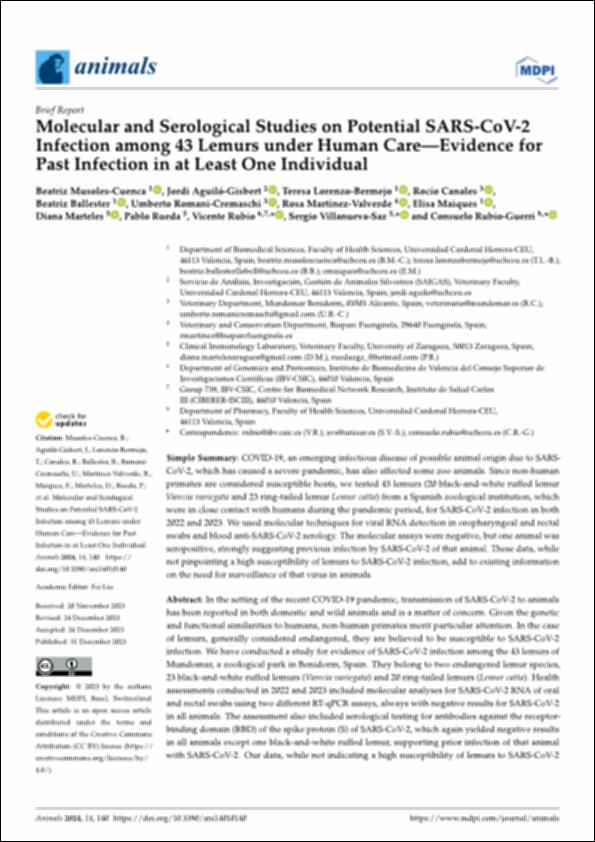Por favor, use este identificador para citar o enlazar este ítem:
http://hdl.handle.net/10637/15088Molecular and serological studies on potential SARS-CoV-2 infection among 43 lemurs under human care-evidence for past infection in at least one individual
| Título : | Molecular and serological studies on potential SARS-CoV-2 infection among 43 lemurs under human care-evidence for past infection in at least one individual |
| Autor : | Musoles Cuenca, Beatriz Aguiló Gisbert, Jordi Lorenzo Bermejo, Teresa Canales, Rocío Ballester Llobell, Beatriz Romani Cremaschi, Umberto Martínez Valverde, Rosa Maiques Fernández, Elisa Marteles, Diana Rueda, Pablo Rubio, Vicente Villanueva Saz, Sergio Rubio Guerri, Consuelo |
| Materias: | SARS-CoV-2 (Virus); Lemurs; Lemures |
| Editorial : | MDPI |
| Citación : | Musoles-Cuenca, B., Aguiló-Gisbert, J., Lorenzo-Bermejo, T., Canales, R., Ballester, B., Romani-Cremaschi, U., Martínez-Valverde, R., Maiques, E., Marteles, D., Rueda, P., Rubio, V., Villanueva-Saz, S. & Rubio-Guerri, C. (2023). Molecular and serological studies on potential SARS-CoV-2 infection among 43 lemurs under human care-evidence for past infection in at least one individual. Animals, vol. 14, i. 1, art. 140 (31 dec.). DOI: https://doi.org/10.3390/ani14010140 |
| Resumen : | In the setting of the recent COVID-19 pandemic, transmission of SARS-CoV-2 to animals has been reported in both domestic and wild animals and is a matter of concern. Given the genetic and functional similarities to humans, non-human primates merit particular attention. In the case of lemurs, generally considered endangered, they are believed to be susceptible to SARS-CoV-2 infection. We have conducted a study for evidence of SARS-CoV-2 infection among the 43 lemurs of Mundomar, a zoological park in Benidorm, Spain. They belong to two endangered lemur species, 23 black-and-white ruffed lemurs (Varecia variegata) and 20 ring-tailed lemurs (Lemur catta). Health assessments conducted in 2022 and 2023 included molecular analyses for SARS-CoV-2 RNA of oral and rectal swabs using two different RT-qPCR assays, always with negative results for SARS-CoV-2 in all animals. The assessment also included serological testing for antibodies against the receptor-binding domain (RBD) of the spike protein (S) of SARS-CoV-2, which again yielded negative results in all animals except one black-and-white ruffed lemur, supporting prior infection of that animal with SARS-CoV-2. Our data, while not indicating a high susceptibility of lemurs to SARS-CoV-2 infection, show that they can be infected, adding to the existing information body on potential ways for SARS-CoV-2 virus spreading in zoos, highlighting the need for animal surveillance for the virus. |
| URI : | http://hdl.handle.net/10637/15088 |
| Derechos: | Open Access https://creativecommons.org/licenses/by/4.0/deed.es |
| ISSN : | 2076-2615 (Electrónico) |
| Fecha de publicación : | 31-dic-2023 |
| Centro : | Universidad Cardenal Herrera-CEU |
| Aparece en las colecciones: | Dpto. Ciencias Biomédicas |
Los ítems de DSpace están protegidos por copyright, con todos los derechos reservados, a menos que se indique lo contrario.


